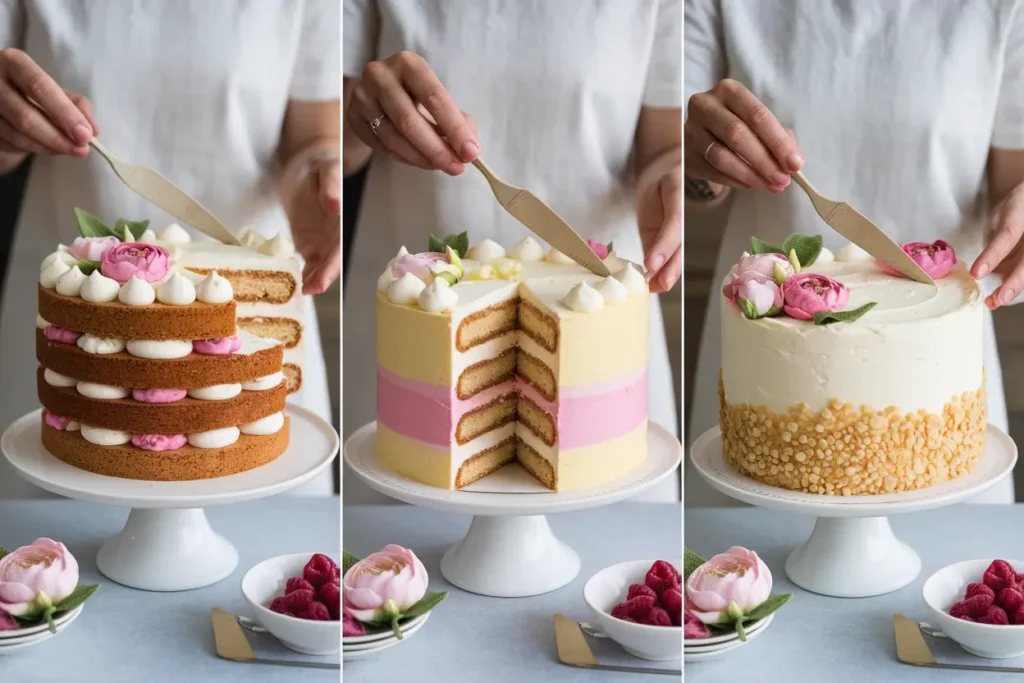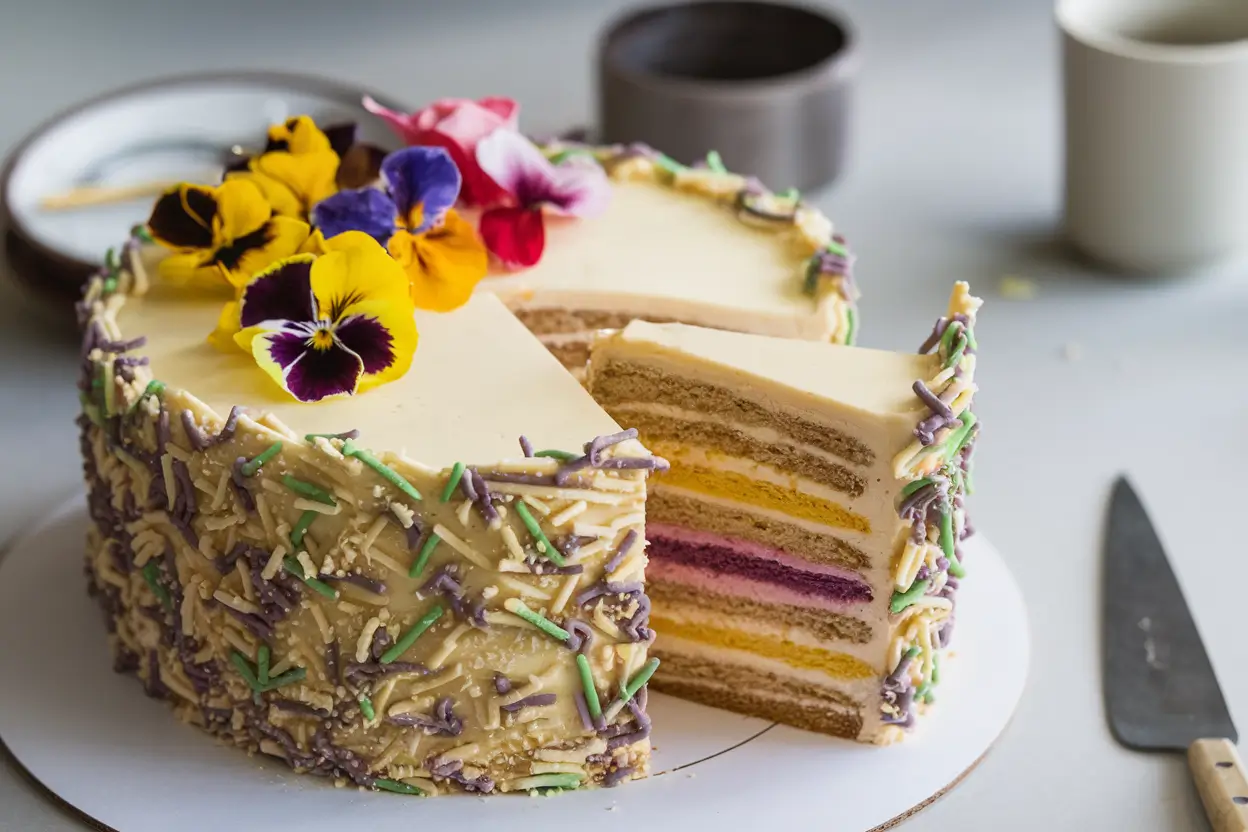Introduction
The Princess Cake, or Prinsesstårta as it’s fondly called in Sweden, is more than just a dessert—it’s a celebration of elegance and tradition. This delightful cake, draped in green almond paste and crowned with a pink rose, has captured the hearts of dessert lovers around the world. From its fascinating royal origins to its delicious flavor, every layer of this cake tells a story. Let’s embark on a journey to uncover the secrets of the Princess Cake, starting with its history and cultural importance.
Introduction to Princess Cake
What Is a Princess Cake?
The Princess Cake is a classic Swedish dessert known for its distinctive appearance and delicate flavor. Traditionally, it consists of layers of light sponge cake, rich pastry cream, tart raspberry jam, and fluffy whipped cream, all encased in a smooth green marzipan cover. Its signature pink almond paste rose on top makes it instantly recognizable.
Originating in Sweden, this dessert has become a staple for special occasions such as birthdays, weddings, and even graduation celebrations. It’s the kind of cake that instantly elevates any event, leaving everyone enchanted by its charm and taste.
Origins and History
The story of the Princess Cake dates back to the 1930s when Jenny Åkerström, a Swedish teacher, first created it for three royalty of the Swedish royal family. The dessert became so beloved by the royalty that it was fondly named after them. Over time, it evolved into a beloved national treasure, symbolizing Swedish culinary artistry and tradition.
Interestingly, the cake was initially pink, not green, and the marzipan’s distinctive hue was a modern twist introduced later. Today, the dessert stands as a testament to Sweden’s rich culinary heritage, blending royal elegance with local flair.
Cultural Significance in Sweden
In Sweden, the Princess Cake isn’t just a dessert; it’s an institution. From bakeries to home kitchens, it’s a fixture during Fika (the Swedish coffee break) or festive gatherings. Its widespread popularity is such that even IKEA offers its version of this iconic dessert, making it accessible to a global audience.
The cake has transcended its royal beginnings to become a symbol of Swedish tradition. It’s a dessert that embodies joy, celebration, and a sense of belonging—a culinary ambassador of Swedish culture.
Composition of a Princess Cake
Traditional Ingredients
The Princess Cake owes its magic to a carefully curated set of ingredients, each contributing to its rich texture and delightful flavor. At its core, this dessert is composed of the following:
- Sponge Cake: A light and fluffy base that forms the foundation of the cake, often flavored with vanilla for a subtle sweetness.
- Raspberry Jam: A thin layer of tart raspberry jam, offering a burst of fruity freshness amidst the creaminess.
- Pastry Cream: A luscious custard filling, rich in texture and flavor, providing a creamy balance to the sponge.
- Whipped Cream: Fluffy and airy, this layer is essential for the cake’s lightness and contributes to its melt-in-the-mouth quality.
- Marzipan: The iconic green marzipan not only seals the cake’s layers but also lends a sweet almond flavor, making it instantly recognizable.
These simple yet harmonious ingredients come together to create a dessert that’s both visually stunning and irresistibly tasty.
Layer Breakdown

Each layer of the Princess Cake serves a unique purpose, both in flavor and aesthetics.
- Base Layer: A firm but airy sponge cake provides the structure for the dessert.
- Jam Layer: Just above the sponge, a thin spread of raspberry jam adds a touch of tartness.
- Pastry Cream: Next, a generous dollop of custard balances the sweetness with its velvety texture.
- Whipped Cream Dome: The whipped cream is carefully shaped into a dome, giving the cake its iconic rounded appearance.
- Marzipan Covering: Finally, the green marzipan is rolled out thinly and draped over the dome, concealing the layers beneath. The cake is topped with a decorative pink marzipan rose and a dusting of powdered sugar for that royal finish.
Variations and Modern Twists
Although the traditional Princess Cake remains a favorite, modern interpretations have emerged, adding exciting twists to this classic dessert:
- Flavor Variations: Some versions incorporate different jams like apricot or blackberry, while others replace pastry cream with chocolate mousse for a richer experience.
- Color Changes: Instead of green marzipan, creative bakers sometimes opt for pastel shades such as pink, lavender, or blue to suit specific themes or celebrations.
- Mini Princess Cakes: Bite-sized versions of this dessert have gained popularity, perfect for individual servings or party favors.
These variations reflect the cake’s versatility while keeping its essence intact, ensuring it remains relevant and loved across generations.
Flavor Profile of Princess Cake
Taste and Texture
The Princess Cake is an enchanting harmony of flavors and textures that keeps dessert lovers coming back for more. Its delicate sponge layers provide a soft, airy foundation, perfectly complemented by the smooth, velvety custard. The tartness of raspberry jam cuts through the sweetness, creating a balanced flavor profile that isn’t overpowering.
The whipped cream adds an ethereal lightness, while the green marzipan offers a subtle almond sweetness and a hint of nuttiness. Each bite delivers a medley of sensations: the melt-in-the-mouth softness of the sponge, the creaminess of the custard, the tang of the jam, and the slightly chewy texture of the marzipan.
Comparisons to Similar Desserts
Though unique in its composition, the Princess Cake shares similarities with other European desserts.
- Black Forest Cake: Like the Princess Cake, it combines layers of sponge, cream, and fruit, but it has a richer, chocolatey profile.
- Italian Cassata: This Sicilian treat also features a marzipan covering but uses ricotta cheese and candied fruit, giving it a more robust flavor.
- French Fraisier: A close cousin, this cake features sponge layers with strawberries and cream but lacks the almond-flavored marzipan.
What sets the Princess Cake apart is its seamless blend of lightness and indulgence, making it a dessert suitable for any occasion—from casual coffee breaks to grand celebrations.
The Making of a Princess Cake
Step-by-Step Preparation
Creating a Princess Cake at home may seem like a daunting task, but with patience and precision, it can become an enjoyable experience. Follow these steps to bring this royal dessert to life:
- Prepare the Sponge Cake:
- Preheat the oven to 350°F (175°C).
- Whisk eggs and sugar until light and fluffy, then fold in sifted flour and baking powder.
- Bake the batter in a round cake pan for 25–30 minutes, then allow it to cool completely before slicing it into three thin layers.
- Make the Pastry Cream:
- Combine milk, sugar, and cornstarch in a saucepan over medium heat.
- Stir continuously until the mixture thickens. Remove from heat and whisk in egg yolks and vanilla extract.
- Chill the cream in the refrigerator until firm.
- Whip the Cream:
- Beat heavy cream with a little sugar until stiff peaks form. Keep chilled until ready to use.
- Assemble the Layers:
- Place the first sponge layer on a cake board and spread a thin layer of raspberry jam.
- Add a generous layer of pastry cream and top with the second sponge layer.
- Repeat the process, ending with a dome of whipped cream on top.
- Roll Out the Marzipan:
- Knead green marzipan until pliable, then roll it out into a thin sheet large enough to cover the entire cake.
- Carefully drape the marzipan over the cake and smooth it down gently. Trim off excess marzipan around the base.
- Decorate the Cake:
- Place a pink marzipan rose at the center of the dome and dust the cake lightly with powdered sugar.
Common Challenges and Tips
Even seasoned bakers can face a few hurdles when making a Princess Cake. Here are some practical tips to ensure success:
- Avoid a Dense Sponge: Be gentle when folding in the flour to retain the airiness of the batter. Overmixing can deflate the cake.
- Prevent Pastry Cream from Curdling: Stir constantly over medium heat and remove from the stove as soon as it thickens.
- Master the Marzipan: Use powdered sugar to prevent sticking while rolling out the marzipan, and ensure it’s evenly thick for a smooth finish.
With practice, these steps will feel more intuitive, and you’ll soon be impressing friends and family with your very own Princess Cake.
Princess Cake in Popular Culture
Appearances in Media
The Princess Cake has become more than a dessert; it’s a cultural icon that has frequently appeared in films, TV shows, and culinary competitions. Its elegant design and intriguing history have made it a favorite subject for pastry chefs and food enthusiasts alike.
- Television Features: The cake has been highlighted in cooking shows like The Great British Bake Off and MasterChef, where contestants attempt to replicate its intricate design and perfect layers.
- Literary Mentions: Some Scandinavian novels and cookbooks reference the Princess Cake as a symbol of Swedish tradition and hospitality.
- Social Media Buzz: On platforms like Instagram and Pinterest, the cake has become a trendsetter, inspiring bakers worldwide to create and share their versions of this iconic dessert.
These appearances have cemented the cake’s reputation as not only a culinary delight but also an artistic masterpiece that continues to inspire creativity and admiration.
Global Popularity and Adaptations
Although deeply rooted in Swedish culture, the Princess Cake has found its way into bakeries and kitchens around the globe. Its unique combination of flavors and textures has led to numerous adaptations:
- European Variations: Many bakeries across Europe have embraced the cake, tweaking it with local flavors like chocolate, citrus, or berry-infused creams.
- American Twists: In the U.S., it’s often a showpiece dessert at upscale bakeries, with some even creating cupcake-sized versions for convenience.
- IKEA’s Role: IKEA has played a significant part in introducing the Princess Cake to an international audience. Their version stays true to tradition while being widely accessible to dessert enthusiasts outside Sweden.
Its adaptability ensures that the Princess Cake continues to captivate people worldwide, offering a sweet taste of Swedish heritage wherever it’s enjoyed.
Frequently Asked Questions About Princess Cake
Why Is It Called a Princess Cake?
The name Princess Cake—or Prinsesstårta in Swedish—stems from its royal beginnings. Jenny Åkerström, a Swedish teacher, crafted the recipe for Princess Margaretha, Princess Märtha, and Princess Astrid in the early 20th century. The cake was so beloved by the princesses that it was named in their honor. Its regal name reflects the elegance and sophistication of this dessert, making it a fitting tribute to Swedish royalty.
What Flavor Is Princess Cake?
The Princess Cake has a delicate flavor that combines sweet, tart, and nutty elements. The light sponge cake offers a vanilla-infused base, complemented by the tangy raspberry jam. The pastry cream adds a creamy richness, while the whipped cream lends an airy lightness. The green marzipan covering imparts a mild almond flavor, tying all the components together into a harmonious taste profile.
What Does Princess Cake Taste Like?
The taste of a Princess Cake is often described as balanced and indulgent without being overwhelming. Its soft sponge and whipped cream create a melt-in-the-mouth texture, while the raspberry jam and custard add layers of complexity. The marzipan provides a subtle sweetness with a hint of nuttiness. Overall, it’s a dessert that’s both light and luxurious, making it a favorite for celebrations.
What Is IKEA Princess Cake?
IKEA’s Princess Cake is a simplified version of the Swedish classic, available at their in-store cafes and Swedish food markets. Staying true to the traditional recipe, it features the signature layers of sponge cake, jam, cream, and green marzipan. IKEA has played a crucial role in introducing this iconic dessert to a global audience, offering a taste of authentic Swedish culture to customers around the world.
Conclusion
The Princess Cake is much more than a dessert; it’s a slice of history, culture, and artistry served on a plate. From its royal beginnings in Sweden to its widespread popularity across the globe, this iconic cake has captivated the hearts and palates of many. Its layers of sponge, cream, jam, and marzipan create a delightful symphony of flavors and textures, making it a dessert worthy of celebration.
Whether enjoyed at a traditional Fika gathering, a festive occasion, or even as a weekend treat, the Princess Cake embodies the joy of indulgence and the timeless appeal of Swedish culinary craftsmanship. Its global adaptations and cultural significance only add to its charm, ensuring that this royal dessert will continue to inspire and delight generations to come.
So, whether you’re baking one from scratch, sampling it at a Swedish bakery, or picking up a slice from IKEA, the Princess Cake invites you to experience the magic of its regal layers. It’s a taste of tradition, a dash of elegance, and a reminder that some desserts are truly timeless.

